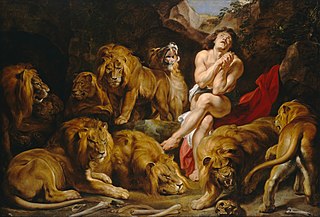 W
WThe Book of Daniel is a 2nd-century BCE biblical apocalypse with a 6th century BCE setting. Ostensibly "an account of the activities and visions of Daniel, a noble Jew exiled at Babylon", it combines a prophecy of history with an eschatology both cosmic in scope and political in focus, and its message is that just as the God of Israel saves Daniel from his enemies, so he would save all Israel in their present oppression.
 W
W"Abomination of desolation" is a phrase from the Book of Daniel describing the pagan sacrifices with which the 2nd century BCE Greek king Antiochus IV replaced the twice-daily offering in the Jewish temple, or alternatively the altar on which such offerings were made. In the 1st century CE it was taken up by the authors of the gospels in the context of the Roman destruction of Jerusalem and the temple in the year 70, with Mark giving Jesus a speech concerning the Second Coming, Matthew 24:15-16 adding a reference to Daniel, and Luke Luke 21:20-21 giving a description of the Roman armies ; in all three it is likely that the authors had in mind a future eschatological event, and perhaps the activities of some anti-Christ.
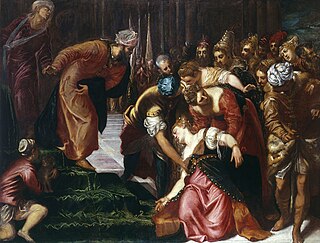 W
WAhasuerus is a name applied in the Hebrew Bible to three rulers and to a Babylonian official in the Book of Tobit.
 W
WAncient of Days is a name for God in the Book of Daniel.
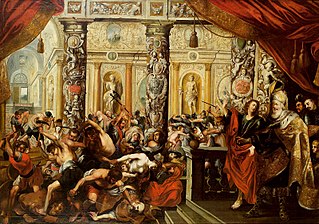 W
WThe narrative of Bel and the Dragon is incorporated as chapter 14 of the extended Book of Daniel. The original Septuagint text in Greek survives in a single manuscript, Codex Chisianus, while the standard text is due to Theodotion, the 2nd-century AD revisor.
 W
WBelshazzar was the son and crown prince of Nabonidus, the last king of the Neo-Babylonian Empire. Through his mother he might have been a grandson of Nebuchadnezzar II, though this is not certain and the claims to kinship with Nebuchadnezzar may have originated from royal propaganda.
 W
WBelshazzar's feast, or the story of the writing on the wall, tells how Belshazzar holds a great feast and drinks from the vessels that had been looted in the destruction of the First Temple. A hand appears and writes on the wall. The terrified Belshazzar calls for his wise men, but they are unable to read the writing. The queen advises him to send for Daniel, renowned for his wisdom. Daniel reminds Belshazzar that his father Nebuchadnezzar, when he became arrogant, was thrown down until he learned that God has sovereignty over the kingdom of men. Belshazzar had likewise blasphemed God, and so God sent this hand. Daniel then reads the message and interprets it: God has numbered Belshazzar's days, he has been weighed and found wanting, and his kingdom will be given to the Medes and the Persians.That very night Belshazzar the Chaldean (Babylonian) king was killed, and Darius the Mede received the kingdom.
 W
WThe Burning Fiery Furnace is an English music drama with music composed by Benjamin Britten, his Opus 77, to a libretto by William Plomer. One of Britten's three Parables for Church Performances, this work received its premiere at the St Bartholomew's Church, Orford, Suffolk, England, on 9 June 1966 by the English Opera Group.
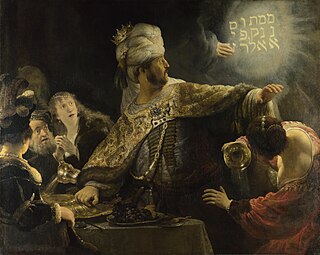 W
WBelshazzar, son of the last king of the Neo-Babylonian empire, Nabonidus, has inspired many works of art and cultural allusions, often with a religious motif. While a historical figure, depictions and portrayals of him are most often based on his appearance in the biblical story of Belshazzar's feast in the Book of Daniel. This story is the origin of the idiomatic expression "the writing is on the wall".
 W
WCyrus II of Persia, commonly known as Cyrus the Great, and also called Cyrus the Elder by the Greeks, was the founder of the Achaemenid Empire, the first Persian empire.
 W
WDaniel is the hero of the biblical Book of Daniel. A noble Jewish youth of Jerusalem, he is taken into captivity by Nebuchadnezzar of Babylon and serves the king and his successors with loyalty and ability until the time of the Persian conqueror Cyrus, all the while remaining true to the God of Israel. The consensus of most modern scholars is that Daniel is not an historical figure and that the book is a cryptic allusion to the reign of the 2nd century BCE Hellenistic king Antiochus IV Epiphanes.
 W
WThe Daniel Fast is a partial fast that is popular among Evangelical Protestants in North America, in which meat, wine, and other rich foods are avoided in favor of vegetables and water for typically three weeks in order to be more sensitive to God. The fast is based on the lifelong kosher diet of the Jewish hero Daniel in the Biblical Book of Daniel and the three-week mourning fast in which Daniel abstained from all meat and wine. A similar observance can be seen with the 40-day season of Lent that is observed by Orthodox, Catholic, and some Mainline Protestant Christians, though the Daniel Fast can be as short as 10 days. The passage in Chapter 1 refers to a 10-day test wherein Daniel and others with him were permitted to eat vegetables and water to avoid the Babylonian king's food and wine. After remaining healthy at the end of the 10-day period, they continued the vegetable diet for the three years of their education. The passage in Chapter 10 refers to a three-week fast of no meat, wine, or rich food.
 W
WDaniel in the lions' den tells of how the biblical Daniel is saved from lions by the God of Israel "because I was found blameless before him". It parallels and complements chapter 3, the story of Shadrach, Meshach, and Abednego: each begins with the jealousy of non-Jews towards successful Jews and an imperial edict requiring them to compromise their religion, and concludes with divine deliverance and a king who confesses the greatness of the God of the Jews and issues an edict of royal protection. The tales making up chapters 1–6 of Daniel date no earlier than the Hellenistic period and were probably originally independent, but were collected in the mid-2nd century BC and expanded shortly afterwards with the visions of the later chapters to produce the modern book.
 W
WDaniel Variations is a composition for large ensemble written by American composer Steve Reich in 2006. It is scored for two soprano and two tenor voices, two clarinets, four pianos, string quartet, and six percussion players. Daniel Variations is in four movements. The first and third movements quote verses from the biblical book of Daniel, while the second and fourth movements use the words of Daniel Pearl, a Jewish American reporter who was kidnapped and murdered by Islamic fundamentalists in Pakistan in 2002.
 W
WDarius the Mede is mentioned in the Book of Daniel as king of Babylon between Belshazzar and Cyrus the Great, but he is not known to history, and no additional king can be placed between the known figures of Belshazzar and Cyrus. Most scholars view him as a literary fiction, but some have tried to harmonise the Book of Daniel with history by identifying him with various known figures, notably Cyrus or Gobryas, the general who was first to enter Babylon when it fell to the Persians in 539 BCE.
 W
WThe Fall of Babylon denotes the end of the Neo-Babylonian Empire after it was conquered by the Achaemenid Empire in 539 BCE.
 W
WThe four kingdoms of Daniel are four kingdoms which, according to the Book of Daniel, precede the "end-times" and the "Kingdom of God".
 W
WIn the Abrahamic religions, Gabriel is an archangel, first described in the Hebrew Bible.
 W
WHabakkuk and the Angel is a sculpture created by Gian Lorenzo Bernini c. 1656–61. Standing in a niche in the Chigi Chapel in the Basilica of Santa Maria del Popolo in Rome, it shows the Prophet Habakkuk with the angel of God. It forms a part of a larger composition with the sculpture of Daniel and the Lion diagonally opposite.
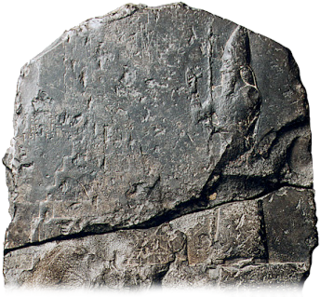 W
WNebuchadnezzar II, also spelled Nebuchadrezzar II, was the second king of the Neo-Babylonian Empire, ruling from the death of his father Nabopolassar in 605 BC to his own death in 562 BC. Historically known as Nebuchadnezzar the Great, he is typically regarded as the empire's greatest king. Nebuchadnezzar remains famous for his military campaigns in the Levant, for his construction projects in his capital, Babylon, and for the important part he played in Jewish history. Ruling for 43 years, Nebuchadnezzar was the longest-reigning king of the Chaldean dynasty. At the time of his death, Nebuchadnezzar was the most powerful ruler in the known world.
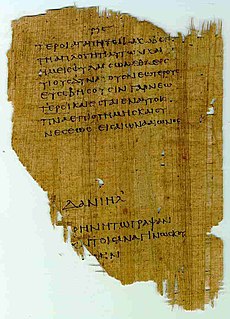 W
WPapyrus 967 is a 3rd-century biblical manuscript, discovered in 1931. It is notable for containing fragments of the original Septuagint text of the Book of Daniel, which was completely superseded by a revised text by the end of the 4th century and elsewhere survives only in Syriac translation and in Codex Chisianus 88. The manuscript is also important for early variants, both in the text of the Book of Ezekiel and of the Book of Daniel.
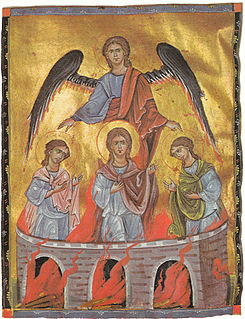 W
WShadrach, Meshach, and Abednego are figures from the biblical Book of Daniel, primarily chapter 3. In the narrative, three Hebrew men are thrown into a fiery furnace by Nebuchadnezzar II, King of Babylon, when they refuse to bow down to the king's image; the three are preserved from harm and the king sees four men walking in the flames, "the fourth ... like a son of God". They are first mentioned in Daniel 1, where alongside Daniel they are brought to Babylon to study Chaldean language and literature with a view to them serving at the King's court, and their Hebrew names are replaced with Chaldean or Babylonian names.
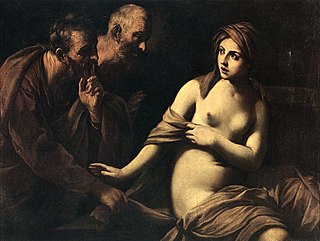 W
WSusanna, also called Susanna and the Elders, is a narrative included in the Book of Daniel by the Roman Catholic and Eastern Orthodox Church. It is one of the additions to Daniel, considered apocryphal by Protestants. It is listed in Article VI of the 39 Articles of the Church of England among the books which are read "for example of life and instruction of manners", but not for the formation of doctrine. It is not included in the Jewish Tanakh and is not mentioned in early Jewish literature, although the text does appear to have been part of the original Septuagint from the 2nd century BC, and was revised by Theodotion, a Hellenistic Jewish redactor of the Septuagint text.
 W
WWatcher is a kind of biblical angel. Watcher occurs in both plural and singular forms in the Book of Daniel, where reference is made to their holiness. The apocryphal Books of Enoch refer to both good and bad Watchers, with a primary focus on the rebellious ones.